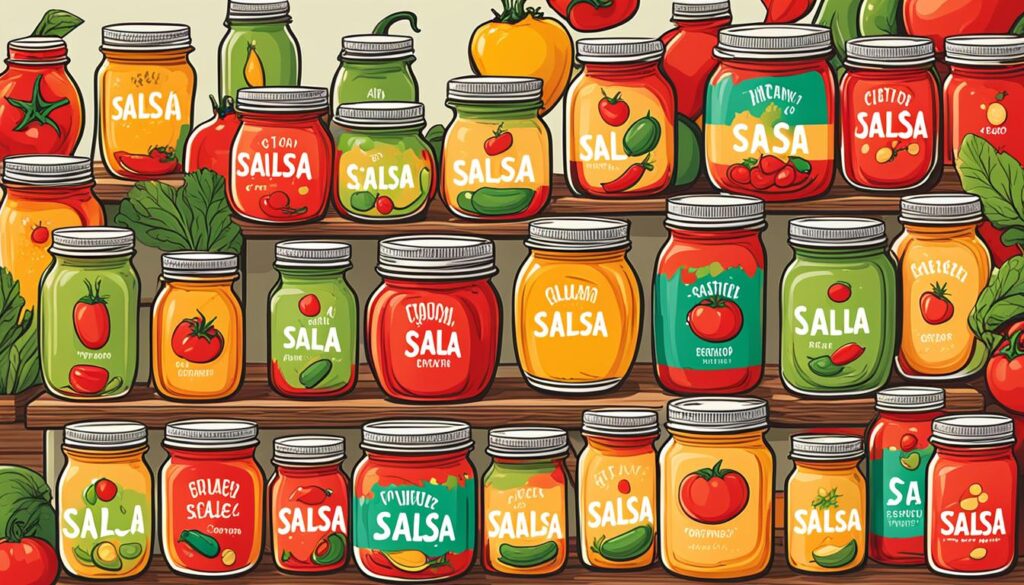Did you know that salsa has surpassed ketchup as America’s favorite condiment? With nearly $1.5 billion in annual sales, the salsa industry is sizzling hot. If your friends and family rave about your homemade salsa and encourage you to sell it, maybe it’s time to turn your passion into a profitable business venture.
Starting a salsa business requires careful planning, hard work, and an entrepreneurial spirit. You’ll need to develop a killer salsa recipe, navigate food safety regulations, and craft effective marketing strategies to stand out in a competitive market. But with dedication and a solid business plan, you can turn your dream of salsa manufacturing into a reality.
From garden fresh salsa (salsa fresca) to fiery red salsa (salsa roja) and tangy green salsa (salsa verde), there are countless variations to explore. You can even venture beyond traditional tomato-based recipes with creative concoctions featuring mango, corn, peach, or black beans. The key is to find a signature flavor that sets your product apart and keeps customers coming back for more.
Key Takeaways
- Salsa is a booming industry with huge potential for aspiring food entrepreneurs
- Launching a successful salsa business requires a unique recipe, solid business planning, and compliance with food safety regulations
- Experimenting with different salsa types and ingredients can help you develop a signature flavor that stands out in the market
- Effective marketing strategies and distribution channels are crucial for building a loyal customer base and growing your salsa brand
- With passion, perseverance, and a willingness to learn, you can turn your love of salsa into a thriving business venture
Discover Your Unique Salsa Recipe
Creating a standout salsa recipe is the foundation of your salsa business’s success. To capture the hearts and taste buds of your customers, you need to develop a signature flavor that sets your salsa apart from the competition. Start by experimenting with different salsa types and ingredients to find the perfect combination that will keep people coming back for more.
Experiment with Different Salsa Types
There are countless salsa varieties to explore, each with its own unique flavor profile. Some popular salsa types include:
- Pico de gallo (fresh salsa)
- Salsa roja (red salsa)
- Salsa verde (green salsa)
- Fruit salsas (mango, pineapple, peach)
- Black bean and corn salsa
Try making different salsa recipes and take note of which ones resonate with your taste testers. Don’t be afraid to think outside the box and combine unexpected ingredients to create a truly unique salsa.
Perfect Your Signature Flavor
Once you’ve narrowed down your favorite salsa types, it’s time to fine-tune your recipe to achieve your signature flavor. This process involves careful salsa ingredient selection, precise measurements, and plenty of taste testing. Consider these factors when perfecting your salsa recipe:
- Balance of flavors (sweet, tangy, spicy)
- Consistency and texture
- Freshness of ingredients
- Unique ingredients or flavor combinations
Gather feedback from friends, family, and potential customers to refine your salsa recipe until it consistently receives rave reviews. Remember, your unique salsa is the key to building a loyal customer base and ensuring the long-term success of your salsa business.
Develop a Comprehensive Salsa Business Plan
Creating a robust salsa business plan is essential for the success of your venture. According to IBISWorld reports, the salsa industry has shown an average annualized growth of 0.4% over the past five years, with expected revenue reaching $954.5 million in 2023 and an estimated increase of 1.2%. This data indicates that the salsa industry is projected to have stable growth in 2024 and shows potential for continuous expansion. Despite the presence of established brands in the salsa market, there is still room for new entrants, making it a welcoming environment for startups.
When developing your salsa business plan, it’s crucial to consider various aspects such as market research, operations management, budgeting, and pricing strategy. Begin by conducting thorough market research to identify your target market and understand their preferences. The rising trend within the salsa industry is towards vegan salsa, with other variations like gluten-free, vegetarian, and plant-based salsa also showing a stable trend. This information can help you tailor your product offerings to meet the demands of your target audience.
Define Your Target Market
Identifying your target market is a critical component of your salsa business plan. Consider factors such as age, income level, lifestyle, and dietary preferences when defining your ideal customer. By understanding your target market, you can develop marketing strategies that effectively reach and engage them, ultimately driving sales and growth for your salsa business.
Outline Your Production Process
Your production process is another essential aspect of your salsa business plan. Determine the steps involved in creating your salsa, from sourcing ingredients to bottling and packaging. Consider factors such as production capacity, equipment requirements, and food safety regulations. By outlining your production process, you can ensure consistency in quality and efficiency in operations.
Create a Financial Projection
Creating a financial projection is crucial for securing funding and managing your salsa business effectively. Develop a detailed budget that includes startup costs, operational expenses, and projected revenue. Consider factors such as ingredient costs, packaging expenses, and pricing strategy when creating your financial projection. By having a clear understanding of your financial landscape, you can make informed decisions and adjust your strategies as needed to ensure the long-term success of your salsa business.
The industry has witnessed an increasing demand for unique and specialized salsa recipes, prompting entrepreneurs to differentiate their product offerings in the market. By creating a comprehensive salsa business plan that encompasses market research, target market definition, production process outline, and financial projection, you can position your salsa business for success in this growing and dynamic industry.
Navigate Legal Requirements and Regulations
Starting a salsa business involves navigating a complex web of legal requirements and food regulations. As a food entrepreneur, it’s crucial to understand and comply with these laws to ensure the safety of your customers and the success of your business. One of the first steps is to contact your local health department and inquire about the necessary permits and licenses required to operate a salsa business in your area.
Depending on your location, you may need to obtain a food handler’s license, which demonstrates your knowledge of safe food handling practices. Additionally, some jurisdictions have specific cottage food laws that govern the production and sale of homemade food items like salsa. These laws may dictate the type of kitchen you can use for production, such as a home kitchen or a commercial space.

If your local regulations require the use of a commercial kitchen, consider renting space from cooking schools, bakeries, or cafes during their off-peak hours. This can be a cost-effective solution for small-scale salsa producers. Once you have secured a suitable production space, be sure to obtain all necessary permits and schedule any required inspections of your bottling location.
To ensure compliance with food safety regulations, consider the following steps:
- Research and understand the specific cottage food laws and regulations in your state, county, and city
- Obtain a food handler’s license by completing a certified training program
- Secure a suitable production space that meets local health department requirements
- Apply for all necessary permits and licenses related to food production and sales
- Schedule and pass all required inspections of your production facility and bottling location
By taking the time to navigate the legal requirements and food regulations governing salsa production, you’ll lay a strong foundation for your business and demonstrate your commitment to providing safe, high-quality products to your customers.
Secure Funding for Your Salsa Startup
Starting a salsa business requires careful financial planning and securing the necessary capital investment to get your venture off the ground. While the costs of launching a salsa startup can vary depending on factors such as production scale, equipment, and marketing expenses, it’s essential to explore various financing options to ensure you have the resources to bring your delicious salsa to market.
Explore Small Business Loans
One popular avenue for securing startup funding is through small business loans. Many banks and financial institutions offer specialized loan programs tailored to the needs of entrepreneurs and small business owners. When approaching lenders, be prepared to present a solid business plan, financial projections, and a clear strategy for how you intend to use the loan proceeds to grow your salsa business. Having a well-crafted pitch and demonstrating your passion and expertise in the salsa industry can increase your chances of securing favorable loan terms.
Consider Crowdfunding Opportunities
In recent years, crowdfunding has emerged as an innovative way for entrepreneurs to raise capital for their ventures. Platforms like Kickstarter and Indiegogo allow you to showcase your salsa business idea to a wide audience of potential investors and customers. By creating a compelling campaign that highlights the unique flavors and quality of your salsa, you can attract backers who believe in your vision and are willing to provide financial support in exchange for rewards or early access to your products. Crowdfunding not only helps you secure funding but also builds buzz and generates valuable exposure for your salsa brand.
In addition to small business loans and crowdfunding, it’s worth exploring other financing options such as angel investors, venture capital firms, or even partnering with established food and beverage companies that may be interested in investing in promising salsa startups. The key is to do your research, network within the industry, and be persistent in pursuing the funding opportunities that align with your business goals and values.
Remember, securing startup funding is just the beginning of your salsa business journey. With careful financial planning, a commitment to producing high-quality salsa, and a passion for sharing your unique flavors with the world, you can turn your salsa startup dreams into a thriving and successful reality.
Establish Your Salsa Production Facility
When starting your salsa business, one of the crucial decisions you’ll need to make is where to produce your salsa. The choice between using your home kitchen or renting a commercial space will depend on various factors, such as your production volume, local regulations, and available resources. Consider the pros and cons of each option to determine the best fit for your salsa production needs.
Choose Between Home Kitchen or Commercial Space
If you’re just starting out and have a limited budget, using your home kitchen for salsa production can be a cost-effective option. However, be sure to check your local cottage food laws and regulations to ensure compliance. As your business grows and you require more space and specialized equipment, transitioning to a commercial kitchen or co-packing facility may become necessary to meet the increasing demand for your salsa.
Invest in Essential Equipment and Supplies
Regardless of your production location, investing in the right equipment and supplies is essential for creating high-quality salsa consistently. Some key items you’ll need include:
- Large-capacity pots and pans for cooking and mixing ingredients
- Food processor or blender for pureeing and chopping
- pH meter to ensure food safety and shelf stability
- Canning jars, lids, and labels for packaging
- Labeling machine for efficient and professional packaging
When sourcing your equipment and supplies, compare prices and reviews from multiple vendors to find the best balance between quality and affordability. Establishing strong relationships with reliable suppliers will help streamline your inventory management and ensure a consistent supply of necessary materials for your salsa production.
As your salsa business expands, you may need to invest in additional equipment, such as larger-capacity cooking and bottling machines, to keep up with the growing demand. Regularly assess your production process and make strategic investments in equipment and supplies to optimize efficiency and maintain the quality of your salsa.
Design Your Salsa Branding and Packaging
Creating a strong brand identity is essential when starting your salsa business. Your salsa branding should reflect the unique qualities of your product and resonate with your target audience. Give careful consideration to your packaging design, as it plays a crucial role in attracting customers and setting your salsa apart from competitors.

When designing your salsa label, include your company logo and contact information. As you learn more about your customer demographics, your logo and label design can evolve to better represent your brand. If you plan to sell your salsa at local craft fairs or only to family and friends, a nutritional analysis or label may not be necessary. However, if you intend to place your product on store shelves, even locally, it’s wise to have an independent company conduct a nutritional analysis, which typically costs less than $1,000 and provides the information needed for a nutritional label.
Consider the following aspects when developing your salsa branding and packaging:
- Choose colors, fonts, and imagery that align with your brand’s personality and target audience
- Ensure your packaging is functional, preserving the quality and freshness of your salsa
- Incorporate product labeling that complies with local and state regulations
- Highlight the unique selling points of your salsa, such as its ingredients or flavor profile
- Work with a graphic designer to create a professional-looking UPC label for your bottles
By investing time and effort into your salsa branding and packaging design, you’ll create a strong foundation for your business and increase the likelihood of attracting and retaining customers.
Develop a Strategic Salsa Marketing Plan
To successfully launch your salsa business and drive customer engagement, you need a comprehensive salsa marketing strategy. Start by leveraging the power of social media platforms to spread the word about your delicious salsas. Creating a strong online presence will help you reach a wider audience and build brand awareness.
Leverage Social Media Platforms
Utilize popular social media channels like Facebook, Instagram, and Twitter to showcase your salsa flavors, share promotions, and engage with your followers. Invest in targeted ads to reach potential customers and encourage them to try your products. Regularly post appealing photos of your salsas, share recipes, and highlight customer reviews to generate buzz and drive sales. Don’t forget to include a link to your online store or a list of physical locations where customers can purchase your salsas.
Participate in Local Events and Markets
Explore opportunities to sell your salsas at local farmers markets, food festivals, and other community events. These venues provide an excellent opportunity to introduce your brand to a new audience and gain valuable feedback from customers. Be sure to check with your local and state governments to understand the regulations surrounding the sale of homemade food products. Each state has its own rules, so it’s essential to research where you’re permitted to sell your salsas.
Partner with Local Businesses
Reach out to local restaurants, grocery stores, and specialty markets to discuss potential business partnerships. Offer to provide them with samples of your salsas and negotiate wholesale prices for bulk orders. By establishing relationships with local businesses, you can expand your distribution network and increase brand visibility. Consider offering in-store demonstrations or tastings to encourage customers to try your products and generate sales.
To further enhance your promotional strategies, get creative with your marketing efforts. Host a salsa tasting party to introduce your products to friends, family, and potential customers. If a market agrees to carry your salsas, volunteer to set up a sample table during peak shopping hours to engage with customers directly. Encourage your network of supporters to spread the word about your delicious salsas and where they can be purchased. By implementing a multi-faceted salsa marketing approach, you’ll be well on your way to building a successful salsa business.
Build a Strong Distribution Network
With approximately 1000 salsa brands competing in the market, both locally and globally, establishing a robust salsa distribution network is crucial for the success of your salsa business. To stand out among the estimated 995 brands claiming to have the best-tasting salsa, you must develop strategic retail partnerships and explore diverse sales channels.
Conducting thorough market research is essential before investing in bottling and distribution to avoid wasting limited funds. Focus your research on identifying customer needs, effective ways to reach them, and emotional triggers that drive purchases. Analyze your competitors to identify their strengths, weaknesses, and gaps in satisfying customer demands. Perform a SWOT analysis to determine your company’s strengths, weaknesses, opportunities, and threats in the salsa market.
Approach Local Grocers and Specialty Stores
Reach out to local grocers and specialty stores to carry your salsa on their shelves. Develop a compelling pitch that highlights your unique selling points, such as your signature flavor, high-quality ingredients, and local roots. Offer competitive wholesale prices and provide excellent customer service to build long-lasting retail partnerships.
Consider offering a variety of product strategies, such as different spice levels (mild, medium, hot) and various salsa types or flavors. Explore unique recipes like French or Cajun to differentiate your brand from competitors. Develop a pricing strategy that ensures competitiveness while maintaining profitability.
Explore Online Sales Channels
In addition to traditional retail partnerships, expand your reach by exploring online sales channels. Develop an e-commerce website that showcases your salsa products, brand story, and unique value proposition. Optimize your website for search engines to improve visibility and attract organic traffic.
Leverage online marketplaces like Amazon, Etsy, and Walmart Marketplace to tap into their vast customer base and streamlined order fulfillment processes. Ensure that your supply chain management and inventory control systems are efficient and reliable to handle online orders seamlessly.
Develop a comprehensive marketing plan that sets clear goals, determines measurement metrics, and selects suitable advertising channels like social media, email marketing, and targeted online ads. Continuously monitor and optimize your online sales strategies to maximize revenue and customer satisfaction.
By building a strong distribution network that encompasses both local retail partnerships and online sales channels, you can effectively expand your salsa business’s reach and ensure long-term success in this highly competitive market.
How to Start a Salsa Business: Ensuring Long-term Success
Running a successful salsa business requires more than just a delicious recipe. It takes entrepreneurship, hard work, and the ability to adapt to changing market conditions. To ensure long-term success, continuously improve your product based on customer feedback and explore new flavors to keep your customers engaged. Building customer loyalty is key – consistently deliver high-quality salsa and provide excellent service to create a dedicated fan base.
Stay on top of industry trends and be ready to adjust your growth strategies when needed. Continuously improve your processes to optimize efficiency and profitability. Successful salsa entrepreneurs have mastered the art of surviving on slim margins. In the consumer packaged goods industry, a gross margin of at least 40% is ideal, but this can be challenging for small-scale salsa makers to achieve.
Think big – aim for national distribution in thousands of stores to benefit from economies of scale. Once you reach this level, those tiny margins per jar can add up, allowing you to invest in marketing, hire staff, and pay yourself a salary. Adapting to change is essential in the dynamic food industry. With passion, perseverance, and a flexible mindset, running your own salsa business can be a rewarding and enjoyable venture.
FAQ
What do I need to start a salsa business?
How much does it cost to start a salsa business?
Do I need a commercial kitchen to make salsa for my business?
How can I fund my salsa business startup?
What are some effective ways to market my salsa business?
How can I get my salsa into stores?
What are the keys to long-term success in the salsa business?
Author
-

Lucas Martinez is an accomplished entrepreneur with a passion for startups. He has launched and scaled multiple businesses, providing pragmatic advice on starting and growing a business.
View all posts



